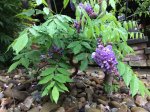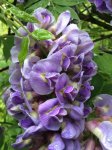Cadillactaste
Neagari Gal
From humble beginnings from a sucker/stick in ground...2014
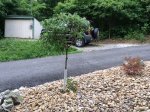
Allowing it to grow a bit...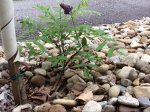
I was thinking a quirky cascade...but if my taste changed...to allow it to develop into something in another direction. So when other branching developed I did clip and grow on them. But wired the cascade in hopes developing a canopy at the end would make it a more defined cascade.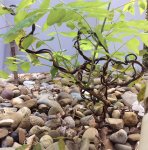


But noticed last year it wasn't as strong as the other style I was growing out. Pondered removal of the cascade branch back then...then thought no need to rush either direction. This year...it didn't wake up. On a Facebook group. Cascades were mentioned...and the strength in keeping the cascade with energy at the end. I didn't do that. I allowed the second direction style go full force in growing and it may have weakened the cascade branch in doing so.
So now...I am pondering a ground layer of just below the two main trunks...making a twin trunk. That is where my gerbil is sending me. I may change my mind once it goes into a pot and I have more control of angle planting in the pot.
Taken last night 2017...
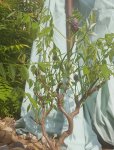
The blooms aren't in the traditional sense...what we think of when we think wisteria. But a great size for bonsai. The base of the layer I'm pondering...is an inch think currently. And the thicker trunk is .60" so just a hair over half an inch. It needs to thicken more in ground before I even contemplate removal of it where it's located. In the meantime, it grows and thickens...and blooms profoundly though the year. Not a one time bloomer at all.
Smallest bloom found on mother tree...
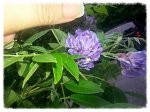
Largest bloom found on mother tree.
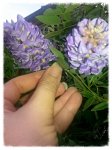

Allowing it to grow a bit...

I was thinking a quirky cascade...but if my taste changed...to allow it to develop into something in another direction. So when other branching developed I did clip and grow on them. But wired the cascade in hopes developing a canopy at the end would make it a more defined cascade.



But noticed last year it wasn't as strong as the other style I was growing out. Pondered removal of the cascade branch back then...then thought no need to rush either direction. This year...it didn't wake up. On a Facebook group. Cascades were mentioned...and the strength in keeping the cascade with energy at the end. I didn't do that. I allowed the second direction style go full force in growing and it may have weakened the cascade branch in doing so.
So now...I am pondering a ground layer of just below the two main trunks...making a twin trunk. That is where my gerbil is sending me. I may change my mind once it goes into a pot and I have more control of angle planting in the pot.
Taken last night 2017...

The blooms aren't in the traditional sense...what we think of when we think wisteria. But a great size for bonsai. The base of the layer I'm pondering...is an inch think currently. And the thicker trunk is .60" so just a hair over half an inch. It needs to thicken more in ground before I even contemplate removal of it where it's located. In the meantime, it grows and thickens...and blooms profoundly though the year. Not a one time bloomer at all.
Smallest bloom found on mother tree...

Largest bloom found on mother tree.

Last edited:

